‘Tis the time of heavy dew mornings, I-spy figs and persimmon gorging days, apricot tinted evenings and chilly nights…the blankets are out, socks and jumpers too…although they’re mostly back in the cupboard by 10am when the sun shines bright and the dew-drops are no longer.
Hello everyone and I am so sorry to have skipped a week. As I explained at the beginning of this adventure, it’s bound to happen from time to time, such is life…and here you are…at home with me, so you’re bound to get some insight to it all! It’s been a hectic fortnight and I feel a bit like I’ve been through the spin cycle and wrung out to dry! I’m thankful now to have a few days of quiet. And grateful that the days I am here are likely punctuated by bucolic vistas to rest the eye for a moment of calm as I go about my daily round of tasks…the routine and discipline required in the nurture of the garden that keep my life grounded where otherwise, like us all…it has the propensity to spin precariously out of control.
Where to begin? I’m tempted to run through the complete garden to-do list of the last fortnight..but now that I’m settled, let’s instead have some fun! And if I need to split this post into two (you know it’s going to tell me it’s too long!) well then…so be it!
The out-of-control began when I zipped down to Melbourne to be at Larry’s side for what is likely to have been the final celebration of his recently released book Why You? It’s not every day in the course of a lifetime that a book is written and he’s had a series of low-key releases…in Sydney, London (I missed that one!), here at Glenmore, Auckland and lastly, Melbourne. I mention it only because…much as it was the reason for my 24 hour round trip, I discovered to my delight that the Melbourne International Flower and Garden Show opened the very next morning! Whoop whoop…I’ve never been before…what a bit of luck! Now there’s a morning off if ever there was!
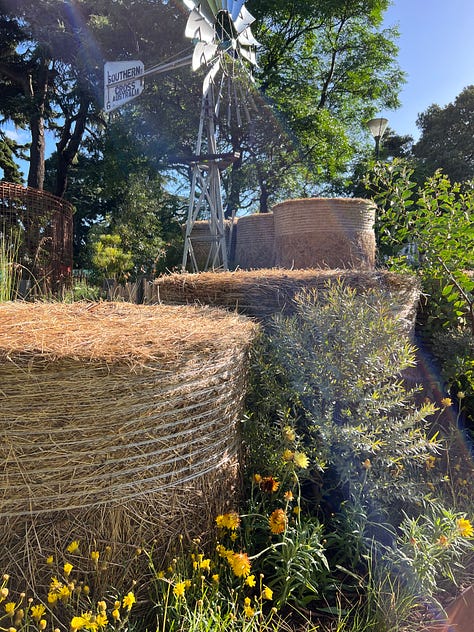
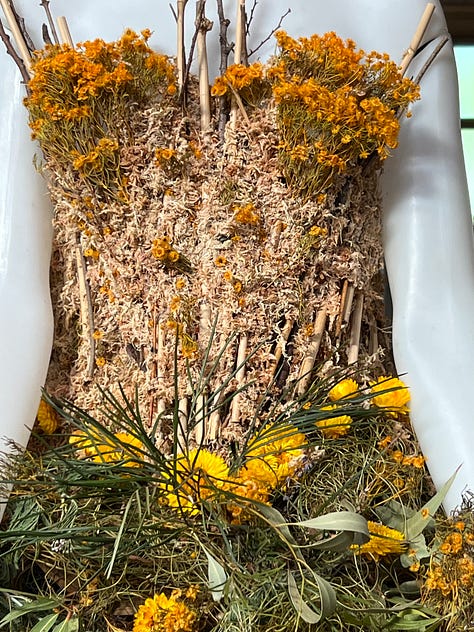
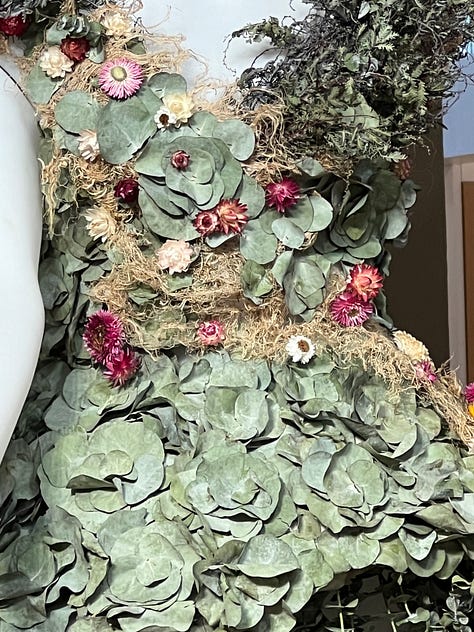
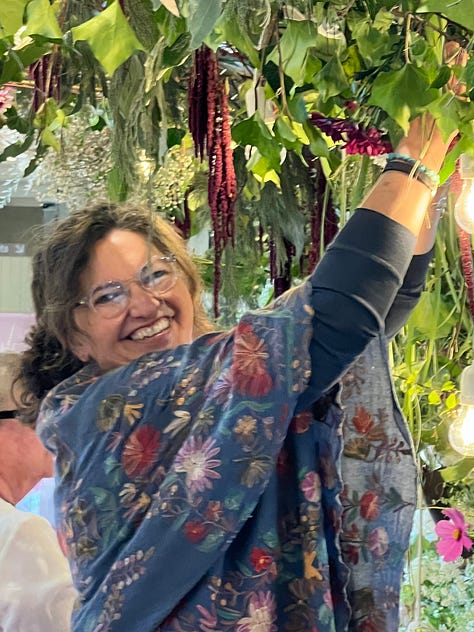
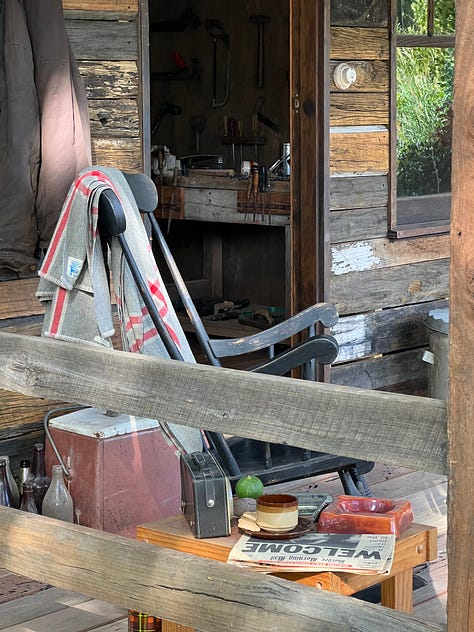
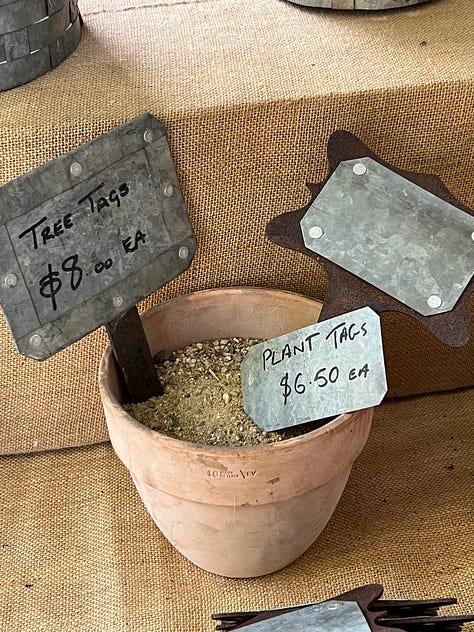
From display gardens: personal favourites ‘Through the Looking Glass’ by STEM Landscape Architecture and Design, with the form of lovely lichen-clad boulders, bolstered by substantial, bound, round bales of hay (how I would have loved to climb them!), prairie planting and a good old Southern Cross windmill; and the ‘Moment in Time’ by Peter Donegan Garden Design, whose narrative suggested an Air Force veteran returning to the remains of a life left behind (rather as the Lost Gardens of Heligan had been…and of course, countless others besides).
The attention to detail in the portrayal of not just the garden, but the shed…complete with transistor radio, newspapers of the era, coffee-stained mugs, old tools cladding the walls…was really fabulous and all was to draw attention to the Australian Defence Force Welfare Association. (Somehow the whole put me in mind of Aaron Bertelsen’s garden at 13A which he’s created over the course of the last couple of years in Hampshire, UK and which I’ve no doubt we’ll all be reading a great deal more about as time goes by. I’ll come back to Aaron another time!).
I do so enjoy how show gardens are inclined to take us on a journey, to give us pause for thought (as well as displaying plant combinations and incorporating materials we may not otherwise have thought to use). Installation of these gardens, be they at Chelsea (without question the pinnacle of such displays!) or Melbourne…requires enormous skill and long-term planning across so many skills and industries and everyone involved deserves huge applause.
Inside the Royal Exhibition Building (1879/80) there were plentiful flower displays, which of course had also been judged on their various merits. This year, the organisers thought to appoint Nadine of The Ivy Institute (who happens to live not too far from here) the role of Sustainability Consultant & Educator…giving her the opportunity to instill, encourage and educate those in the industry to take a more earth conscious and sustainable approach to their floristry practice. I’m in full support, of course! It’s something we’ve talked about a lot here (especially at all those flower workshops I’ve run with lovely Jardine Hansen) and there was some good messaging at the show: not all flowers are grown equal…support grown not flown (according to one display around 50% of flowers sold in Australia are grown overseas which is not OK…this means a higher carbon footprint and of course they’ve all been fumigated). No floral foam has long been the catch-cry of florists who have care for the environment in their mind and their hearts. I had a long chat with Nadine in her ‘Tunnel of Nature Love’ where she was encouraging visitors to pick a flower, give it a kiss, make a wish and tie it to the tunnel of nature love…which they were doing in droves as we chatted! One of her young students happened by and…how very inspiring it was to see first hand that the future of the floristry industry is likely to be in safe hands as the messaging engulfs the next enthusiastic generation.
The standout display for me was the Floral Fashion Project, created by students of RMIT and sponsored by Bush Flowers and Plants, with all the botanical material used by the students sourced from local Victorian and Australian growers. With the theme Natural Beauty, RMIT fashion students explored the potential of material making techniques to creatively transform Australian native plant matter into the fashion context, using seasonal, native flowers and foliage along naturally dyed garments, speaking to sustainable and regenerative materials and design processes, as well as considering design lifecycle concerns such as durability and circularity.
If only we could all get about in such exquisite costumery every day! I’m sure we would walk much taller! And do you know? From the golden ‘Wattle Warrior’ to the captivating ‘With the Wind’ and half a dozen or so more (each a combined effort of the work of several students), it occurred to me their exhibit was the only one at the entire show where I was aware of any kind of scent in the atmosphere…the pungent aroma of eucalypt emanating from their creations…literally stopped me in my tracks!
And then…there were also the bundles of info that one inevitably picks up at such a show…that’s part of the fun! I have no intention of erecting a glasshouse and yet…(Emma-Jane at The Still Room has had such success with hers this year - the quantity of tomatoes she produced in that hothouse was simply outstanding!). Nor do I have any intention of installing an outdoor slow-burning fire with flu but gee-whizz those ones on display were sensational…and who knows when I may have a client who could do with such a thing? I decided not to get carried away with plant looking (I couldn’t take them on the plane home anyway and know how easy it is to fall for the wrong kind of plant on a whim!) but was thrilled to find a maker from central Victoria who is crafting seriously heavy gauge hinges, handles and all kinds of useful things…as well as some plant tags that just might be exactly what I’ve been looking for to use in the Field!
It was quite a morning!
And now I’ve learned to upload a ‘gallery’ of images!! Let’s put that new found skill to the test shall we?
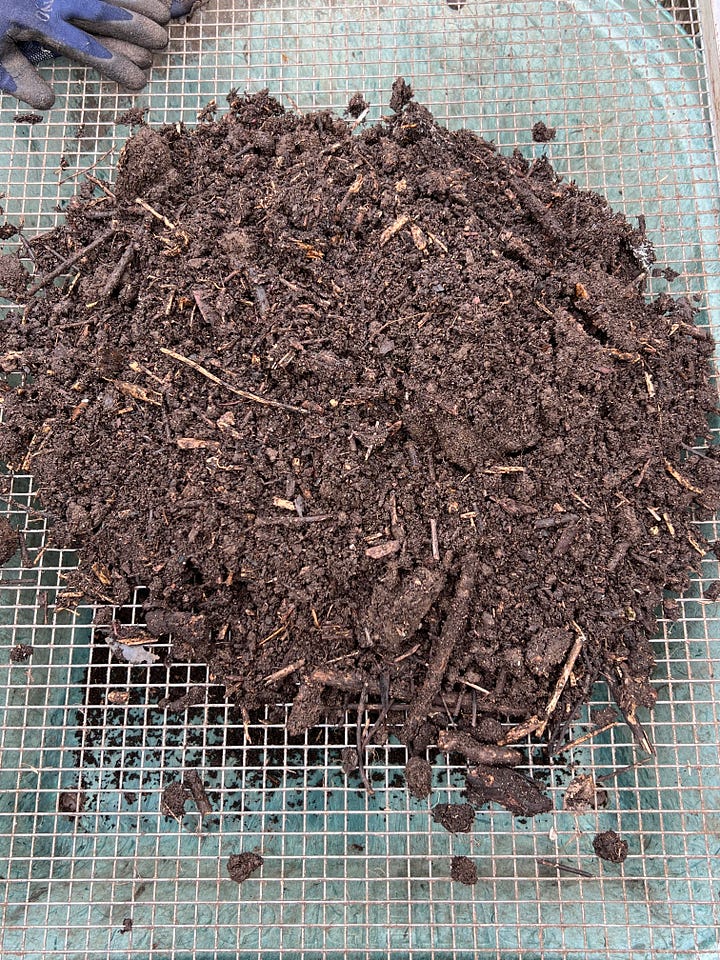
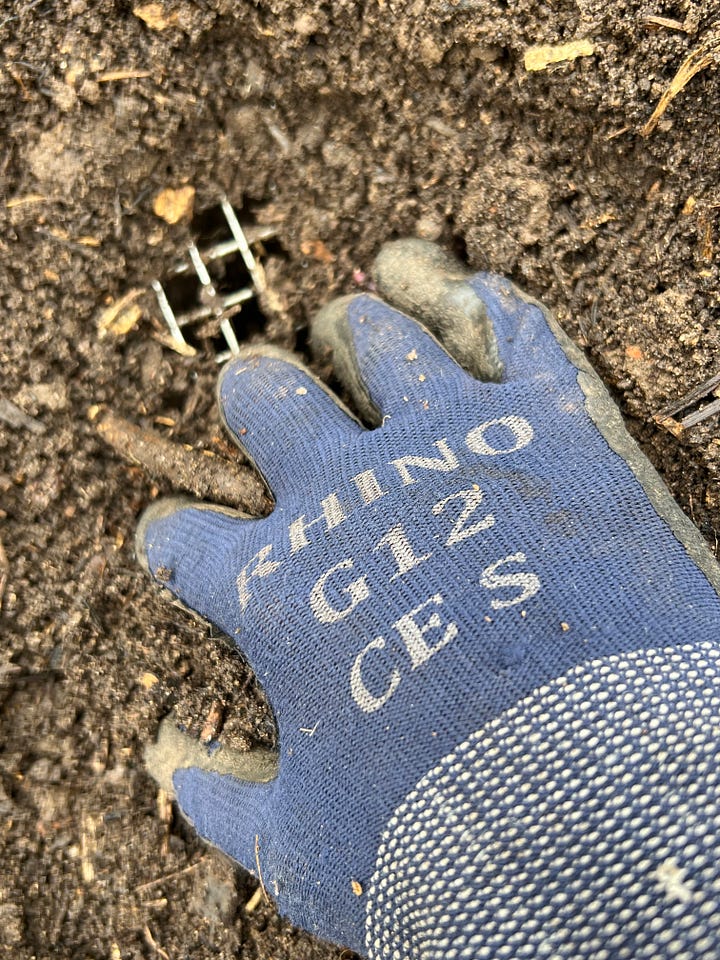
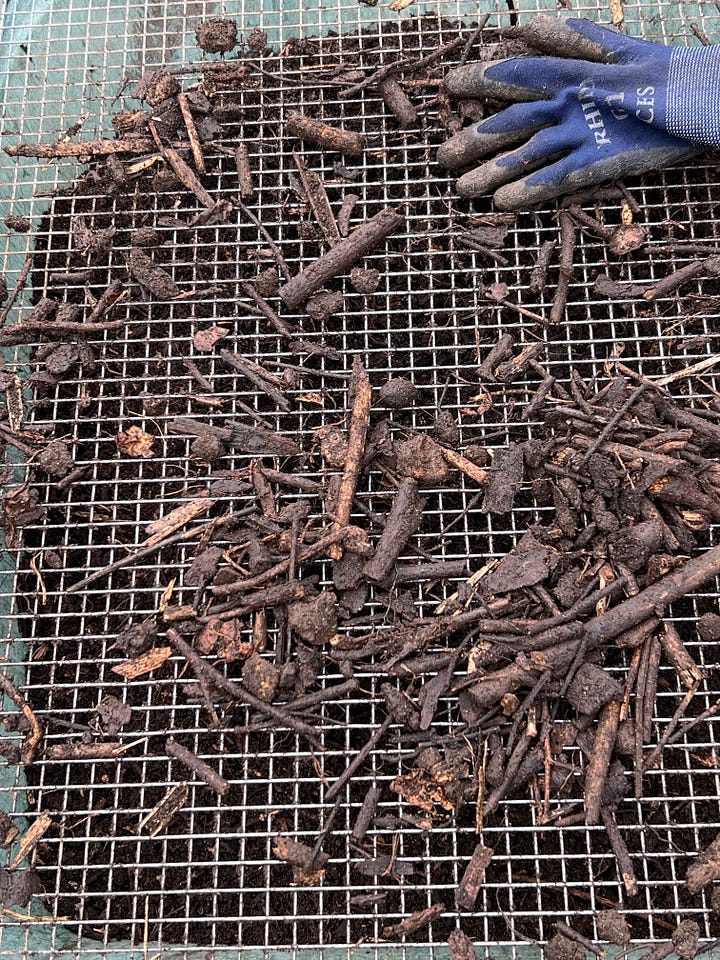
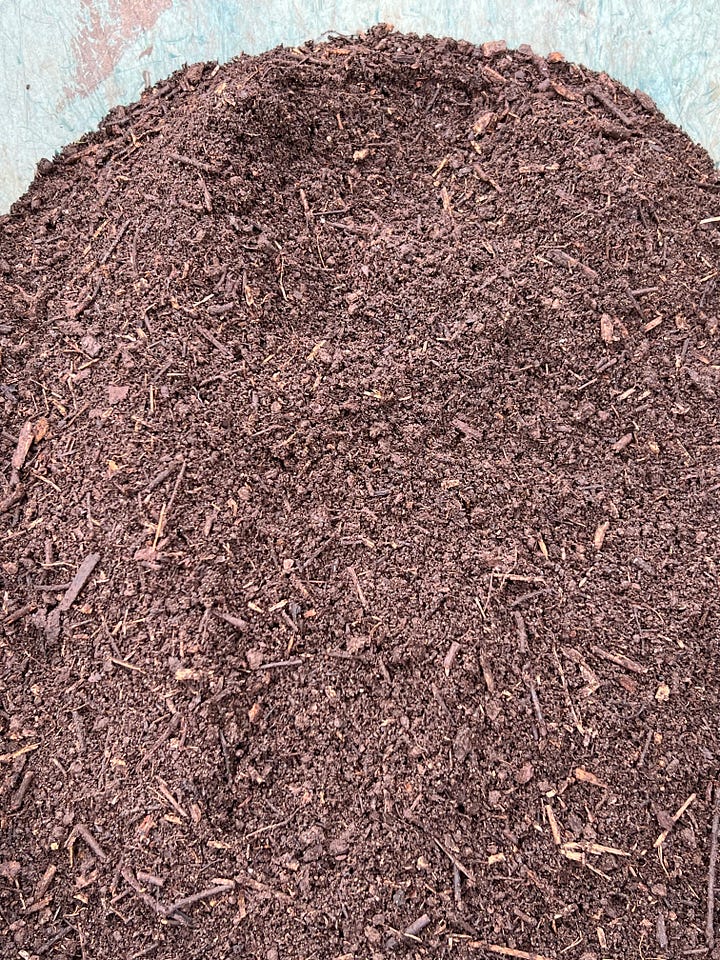
The preceding weekend had been a full one in the garden…naturally! It began with the weekly Tom-tying, zucchini leaf clean-up and brassica white cabbage moth check after the daily water…and then progressed…first, to sieving a good barrow’s worth of compost! I still had seedlings to plant out following the previous weekend’s big effort, as well as a couple of spots requiring the addition of compost, as the crop rotation process continues.
I’ve discovered over the years, that compost needs ‘sorting’ at one end, or the other. For quite some years I tried to categorise or separate materials at the time of pruning…leaving very thick stems, for example, or some very chewy ones (like ginger), that take a very long time to break down, out of the main heap. But I came to realise it was quicker to just chuck it all in…as at the time of pruning I really just want to get on with the job. And so instead, I sieve out anything that hasn’t yet broken down at the ‘ready compost’ end. Whilst the images above show only small twigs (that was a good shovel load!) there are always some quite big chunky sections which (I believe) are quite beneficial to have in the heap during the composting process as they create air passages…a key element in the process of making good compost.
My overflow row of chard seedlings sown and an extra row of lettuce too, I moved onto cutting down some very tall stems of fennel.
This is a task that’s been occurring piecemeal these last weeks across the kitchen garden and…down the back…that working area of the garden I love so much! Between us, Thalia and I have cut down many stems that during the spring and summer seasons, had cast a romantic, soft yellow haze that danced in the breeze, attracting a multitude of bees and ladybirds all the while.
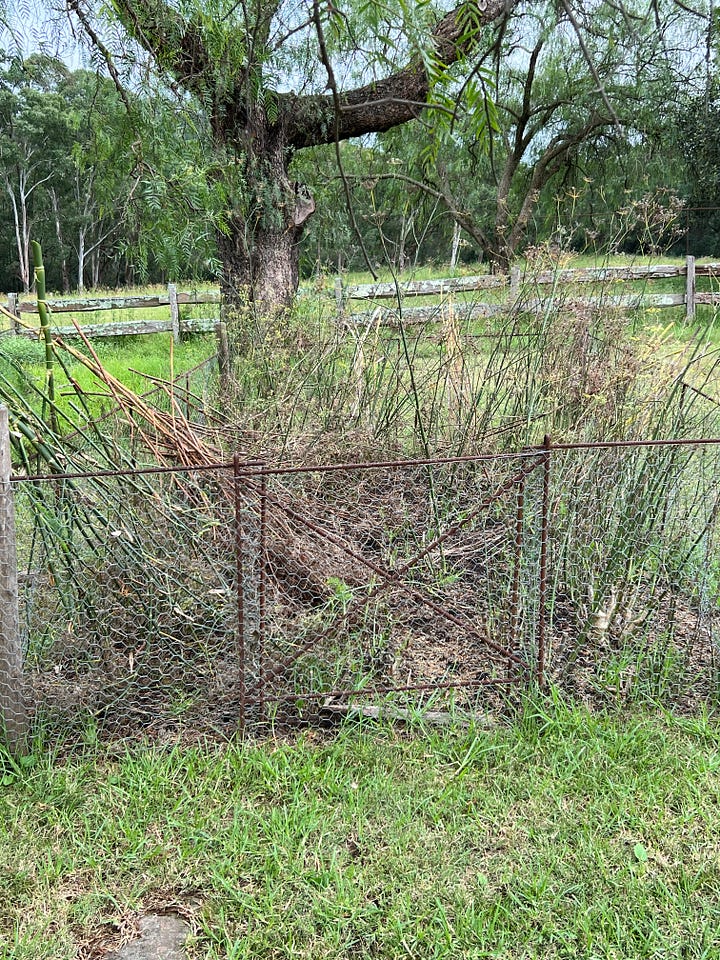
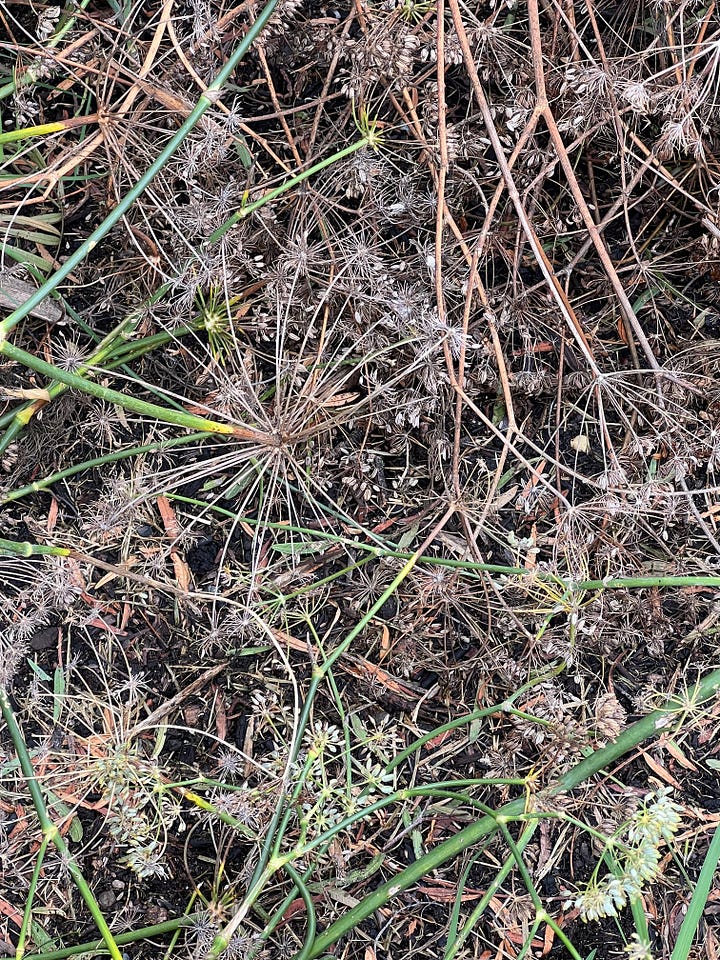
By now, most of those stems are spent and gradually, as they’re cut down, we’ve each been tipping them ‘seedhead-down’ into one of the floating enclosures that I call my ‘bee superhighway’, set as they are between the beehives and the kitchen garden - they provide a series of landing pads (or at least, I like to think so!). I also have a real ‘thing’ for little enclosures! The one above was a bit thin on plant numbers this year, so hopefully by tipping in a vast number of stems we’ll cause some germination of new plants for the season ahead.
At the same time, I’m also collecting whole dried seed heads for cooking (and I’ll come back to that story in a few weeks time!).
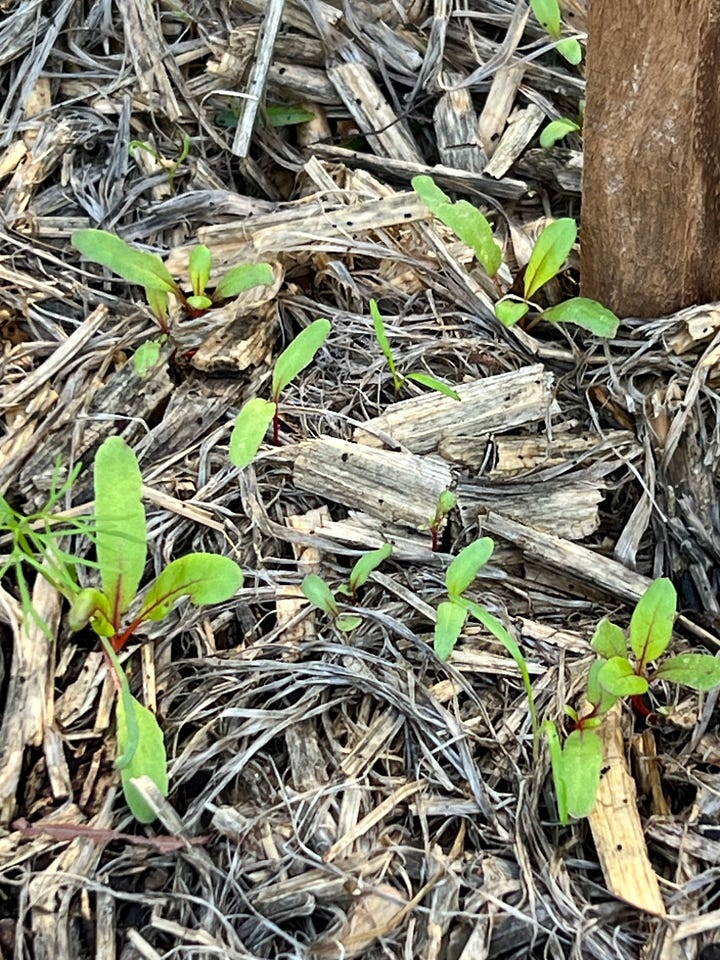
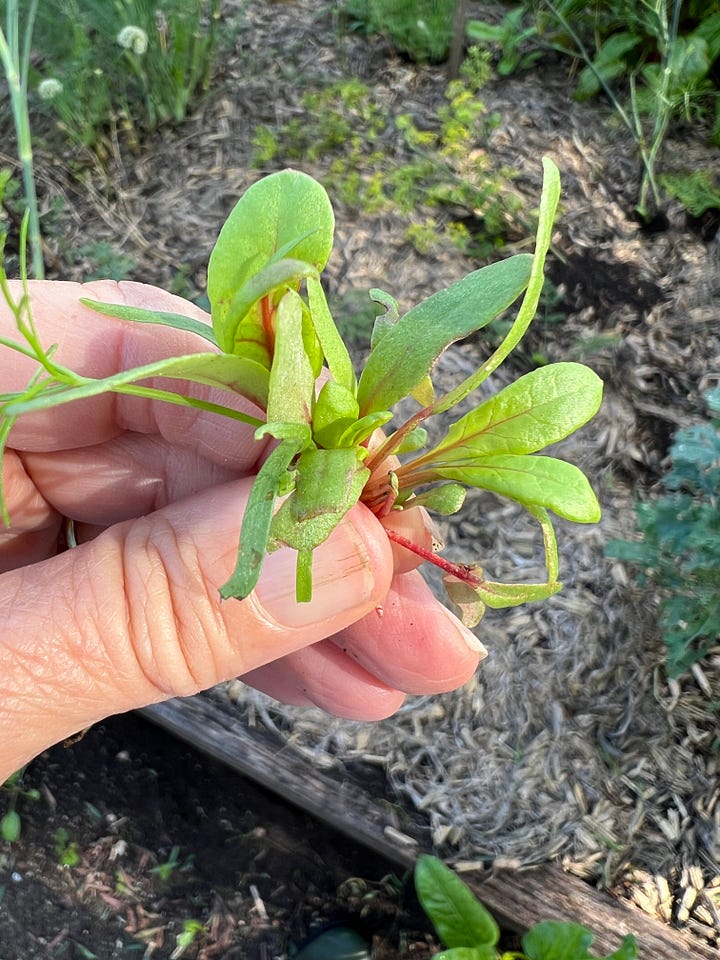
Of course all this cutting down of seed on high equals, as I mentioned a few weeks ago, seed pinging off everywhere! It’s very localised though, and whilst some peeps may think this annoying, I choose to think of it as being simply fabulous! Given just the right temperature, and a little water (even those heavy morning dews are enough), a trickle of newly germinated seedlings soon show themselves. I believe this suggests the time is right to sow seed (if they’re doing it of their own accord, then oughtn’t we pay attention and follow their lead?). Those tiny seedlings are tasty as can be! They simply pop with flavour and I often scoop up a bunch to eat on the run…as well as collecting a bunch or two in the evenings to scatter over or into whatever is on our plates…how foolish I would be, not to take advantage of a bounty of tasty, volunteer nutrition!
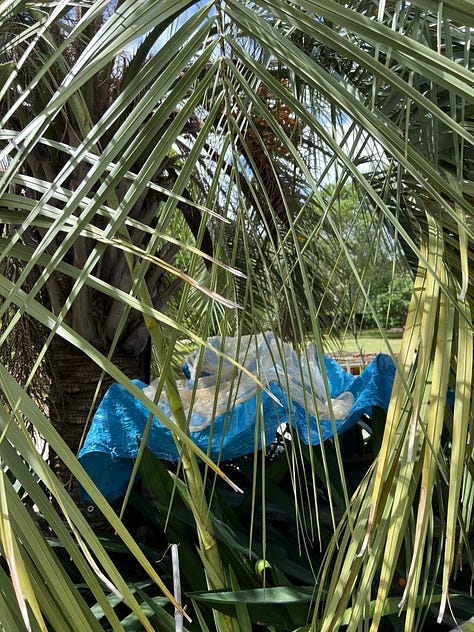
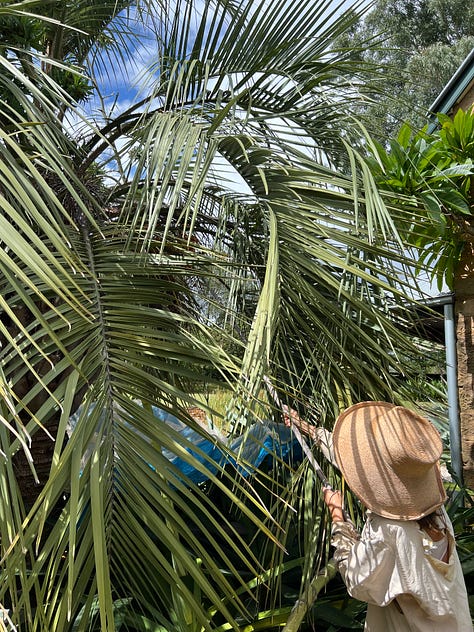
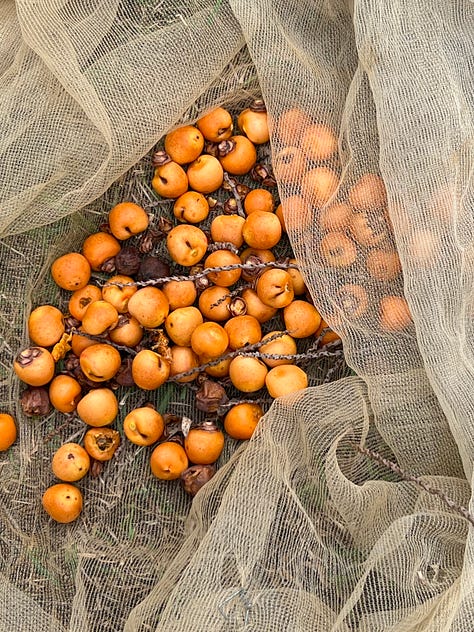
A real fly in the ointment that weekend was how to get the fruit of the Jelly Wine Palm Butia capitata, that I mentioned last time…down from their inflorescence! Too high to cut (and anyway hanging over a mistaken planting of spiky aloes!) this proved quite a challenge! With a plastic tarp over the spikes (that tore straight through anyway!) and a net to save the fruit landing on dusty plastic), bamboo rod in hand, I eventually managed to rustle and coax enough down from their lofty position! (Luckily Clemmie was here to catch one end of the tarp as I flung it across…I’m not sure this would have worked entirely single-handed!). I ate a couple of fruit raw (they still give me the tingles!) and then popped them into a baking tray to cook for an hour or so. As I couldn’t decide what to do with them then and there, they sat in the fridge for a couple of days and then I removed the seeds and put all the flesh (skin on…I didn’t have time to fiddle!) into the freezer! I ate a few along the way and I’m thinking…they will make into a delicious ice cream when the time is right. Funny…this time around I think they taste quite like Cape Gooseberries…and I thought to make those into ice cream for the first time last year with great success. So…I’ll let you know when I do it! I’m kind of glad this task doesn’t come around too often but oh the tantalising smell of it all was simply sensational!
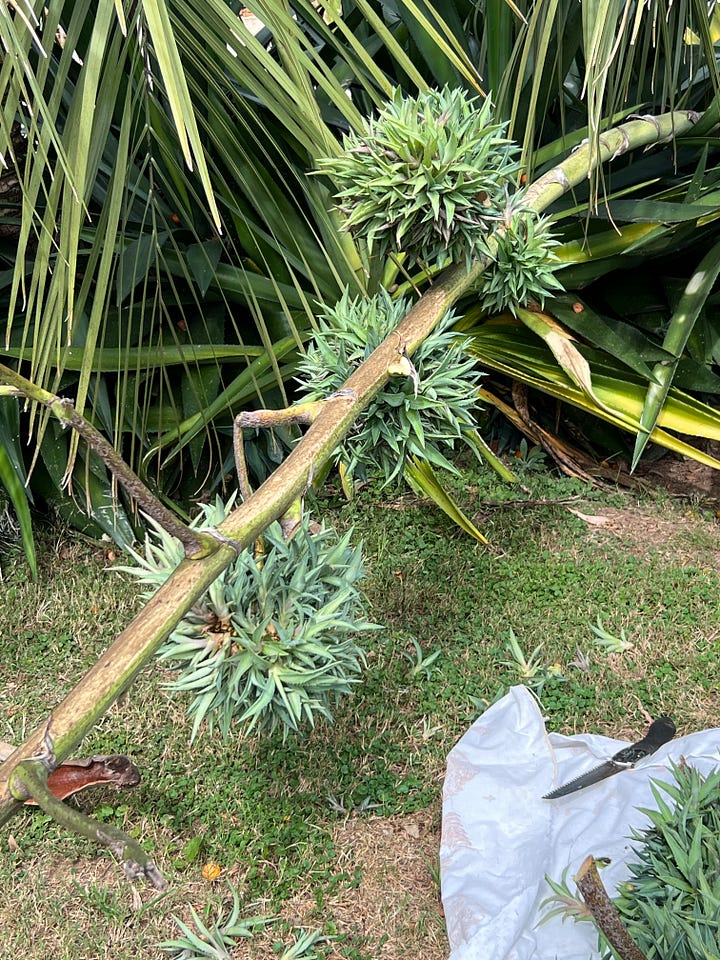
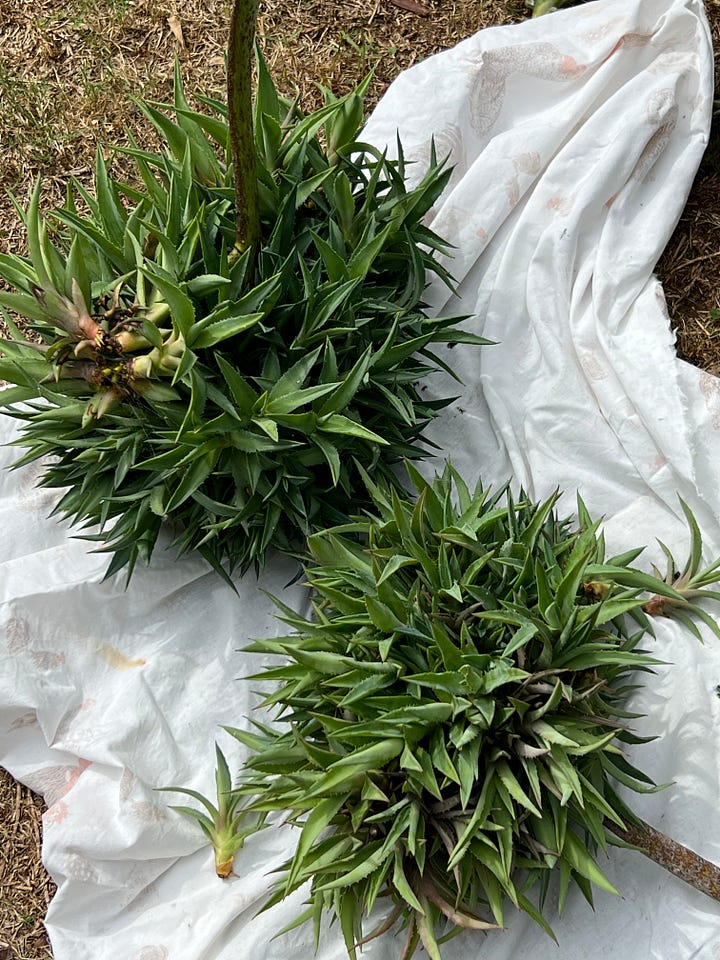
In exactly the same spot as the palm, a calamity occurred the week before when the tall flower spike of one of the Aloes came crashing down (just what caused it I’ve no idea). So there it sat…
I remember being quite astonished the first time one of those mistaken plants sent up its giant asparagus like stem, then extended horizontal branches before its antenna like flowers protruded like some kind of mechanical creature. For all that, the most spectacular part of the Aloe flower journey for me, are the spheres of ‘pups’ it sets…seemingly hundreds of baby new plants! It’s no wonder they’ve spread so far and wide around this District. But let’s set that aside for now…the ongoing problems of mistaken Colonial planting is quite a topic that’s not for today. I’d originally intended these specimens for pots when (what seems like a lifetime ago) I asked the very kindly, now late Mrs Downes at Brownlow Hill if I might have a couple from her densley planted drive. Take as many as you like, was her response as she got stuck into helping me pull them with great enthusiasm! As a result I returned home with many more than intended, and many more than I needed for my pots…so I thought I’d just ‘heel them in’ at that corner of the house…’just for now’. Ha! Was that the most silly idea of all? How I do love them though, around the base of the Palm! And from time to time, they cause sheer chaos as after flowering, we literally need to don armour-plating to remove the dead specimen that always occurs post-flower spike!
Never one to waste an opportunity…for the time being anyway, I have a rather spectacular installation in the Dairy!
Do you recall how last time I explained the Persimmons needed to ripen ‘til they looked like they were about to explode? Hopefully this image explains just that moment…when the skin is so fine you almost expect it to rip apart before your eyes.
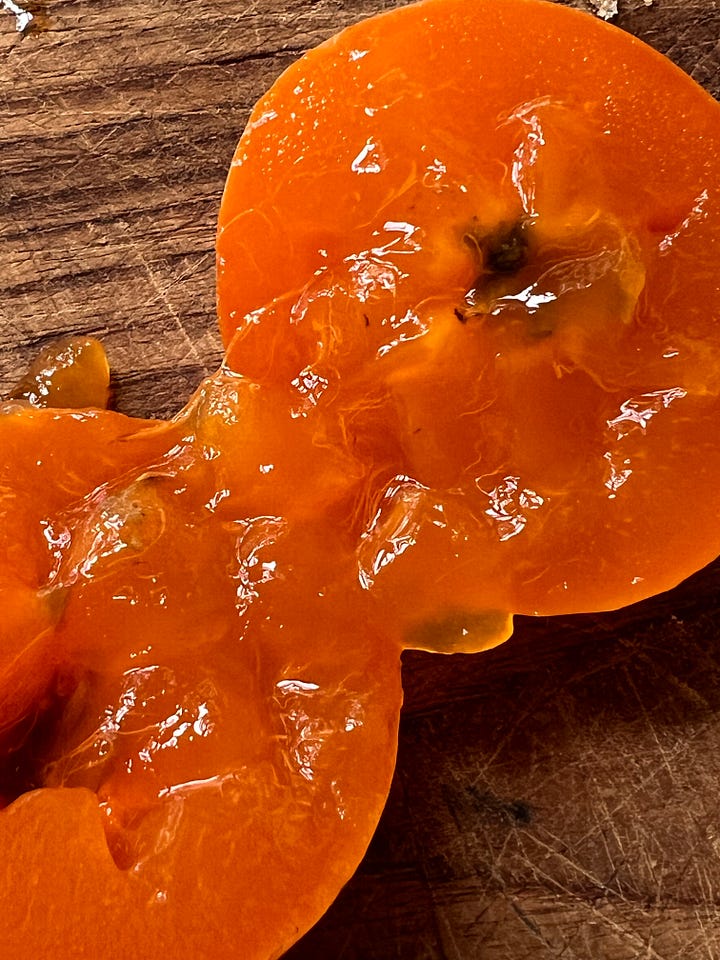
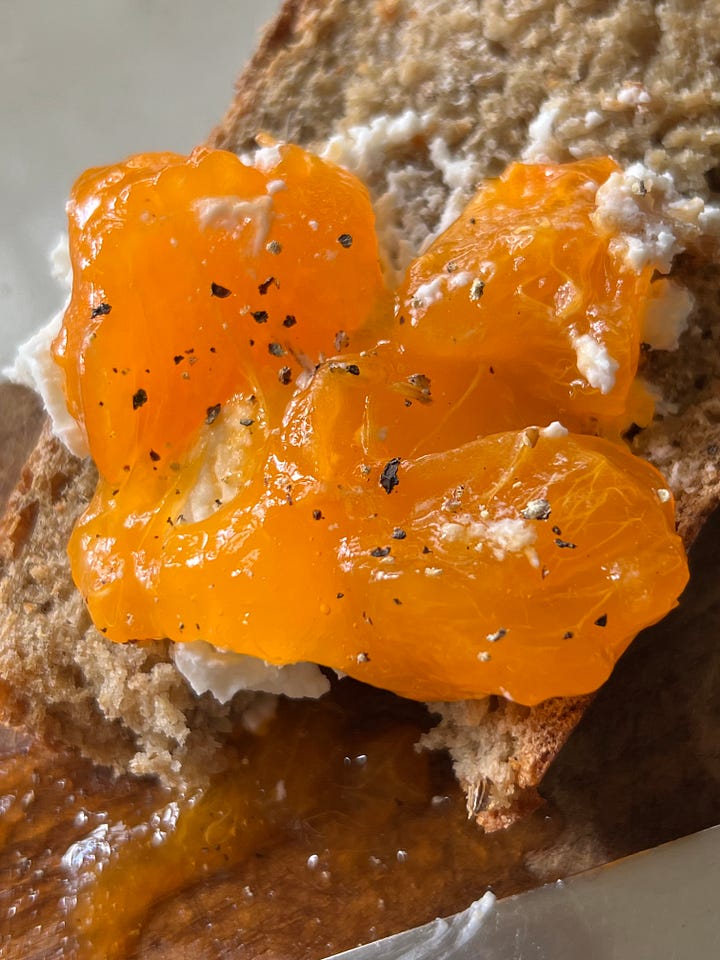
It’s then that the inside is like jelly…and my favourite way to eat it (aside from just scooping the flesh out with a teaspoon) is to mound it onto a slice of toast with a generous spread of chèvre (or Philly cream cheese…afterall this kind of astringent fruit goes with the Philly era in my book!). The fruit on the right was a couple of days less ripe than the fruit on the left. I’ve often thought if I was caught out eating this (as I’m inclined to do mid-week, literally standing in my little corner near the kitchen sink for a quick bite in the middle of the day, briefly away from my desk) that anyone might think I’m eating an obscene amount of apricot jam!
Oh but there was work to do in the Field! First, the ‘saw-pruning’ in the Damask roses I hadn’t had time to complete the weekend before and then…a first pass in the row of aromatic indigenous plants. Their pungent aroma was calling and it was just the kind of job I was in the mood for after all that work with spikes and thorns…(now there’s a relevant topic for today as I sit here tippety-tapping away here this Good Friday)…
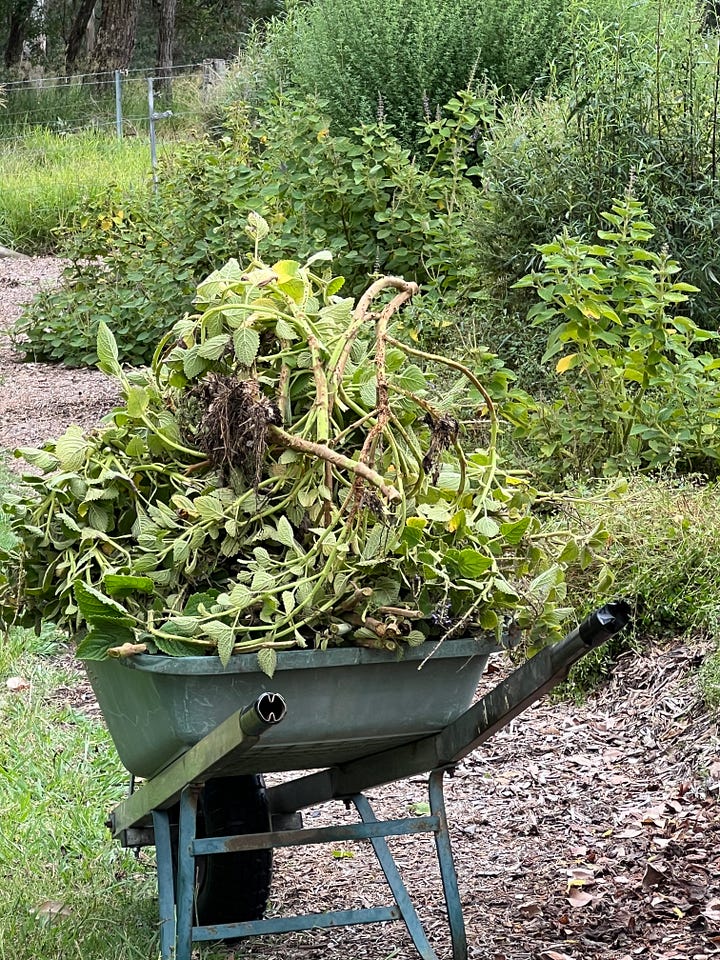
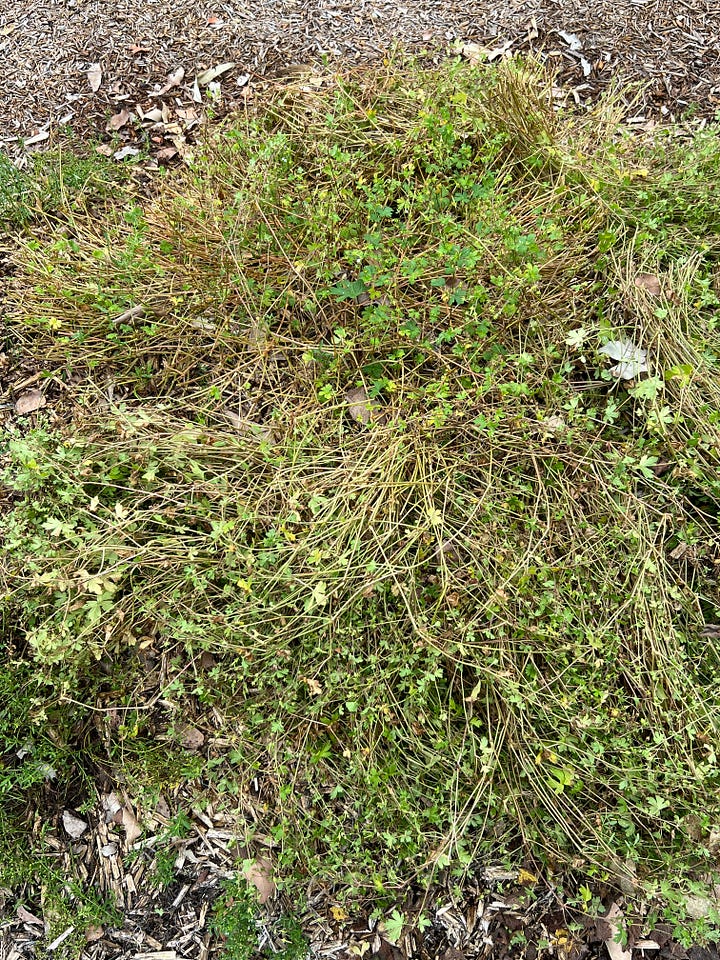
Whilst much of my pruning material was of the dense, balsam-like and almost fleshy to the touch…Plectranthus graveolens that filled the barrow with little difficulty, releasing its evocative odour with every cut I made, another plant I had a wonderful time with was the little native Geranium homeanum that inhabits our creek, but in this instance, I opted for the chop ‘n drop method, leaving my prunings behind. The results are more clear to see now (almost a fortnight on) where each plant looks to inhabit its own little nest.
As I began this post with the dawn, so I think I’ll leave you with the late afternoon light, looking towards Rowan’s hill. It will soon look like this again today, as I go about this evening’s round and…as I’m only half way through reporting the fortnight’s tasks,I’m thinking to pick up last weekend’s gardening activities and so catch-you-up, if I can…tomorrow!
Have a peaceful Good Friday eve all. Mickey x

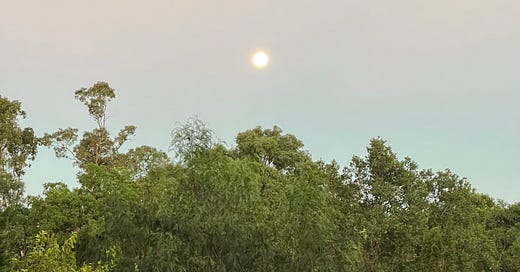




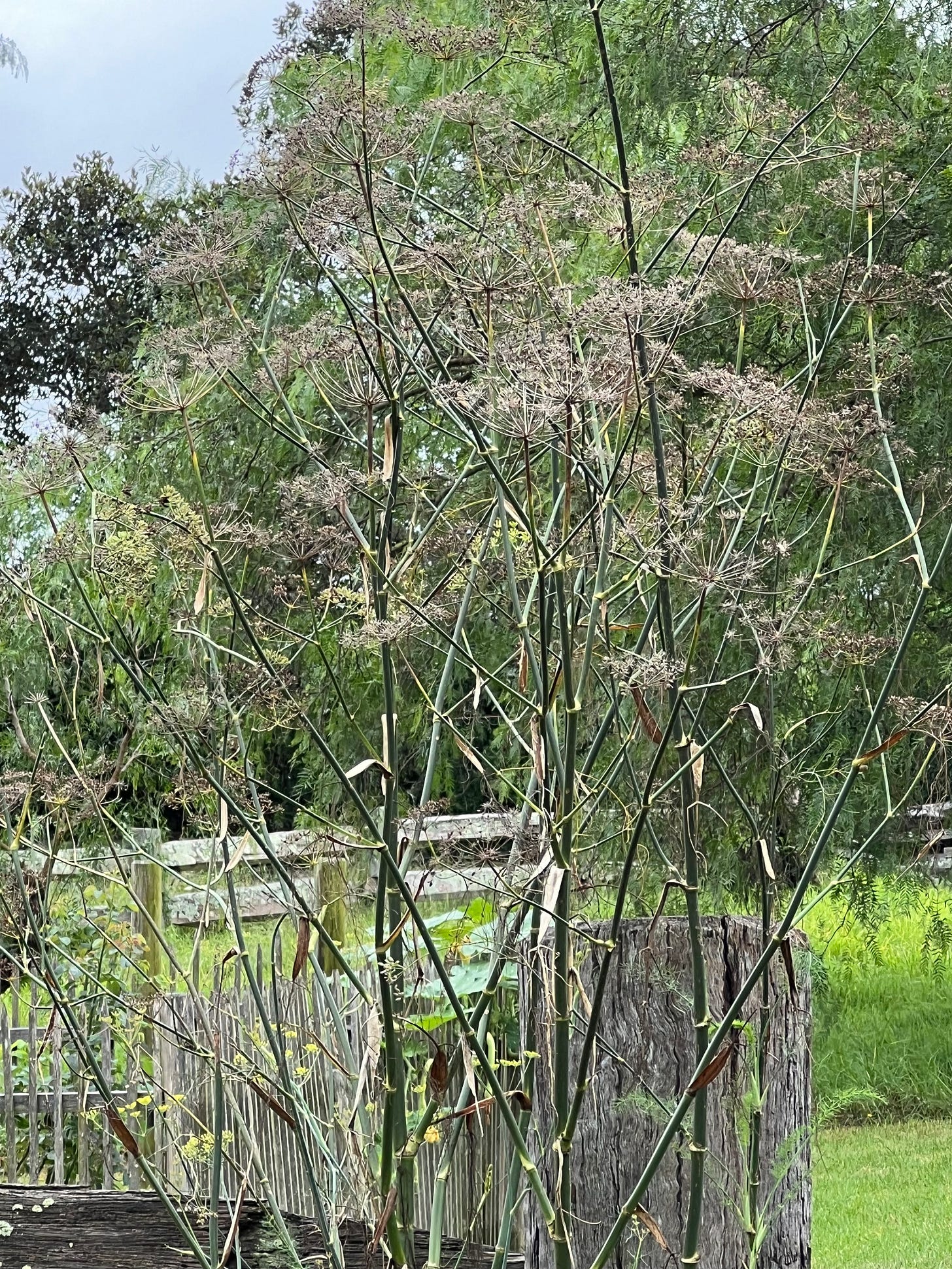

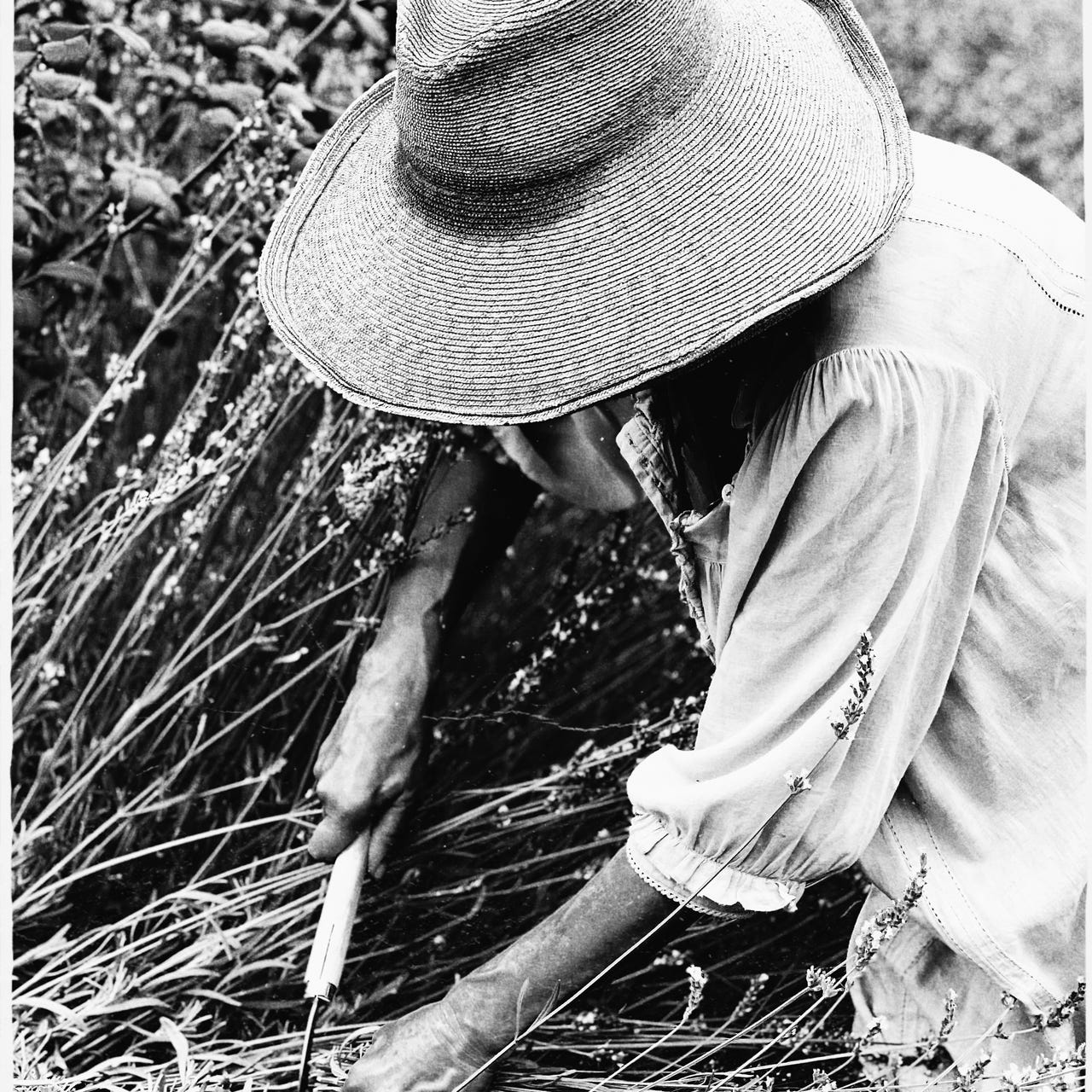
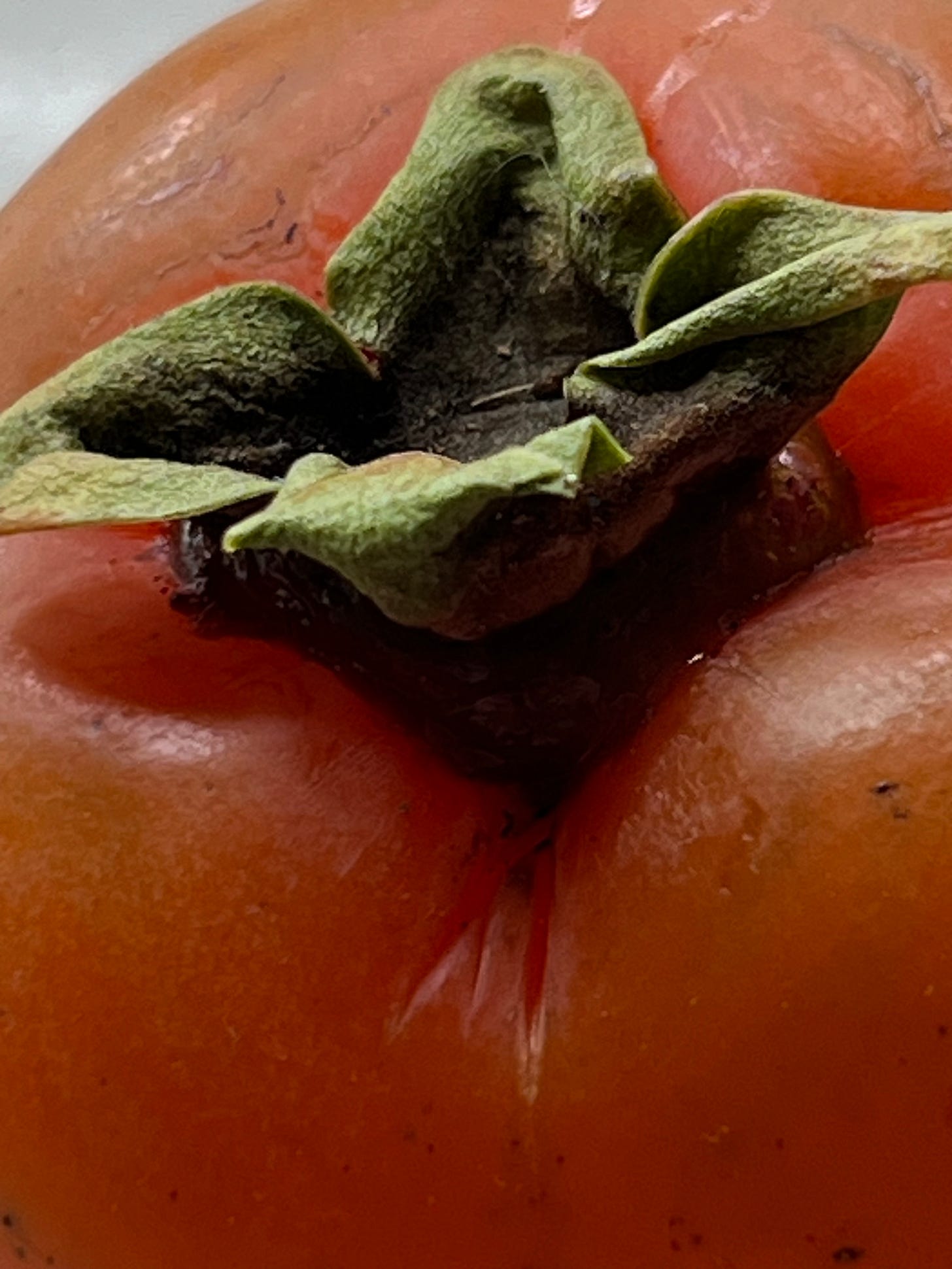
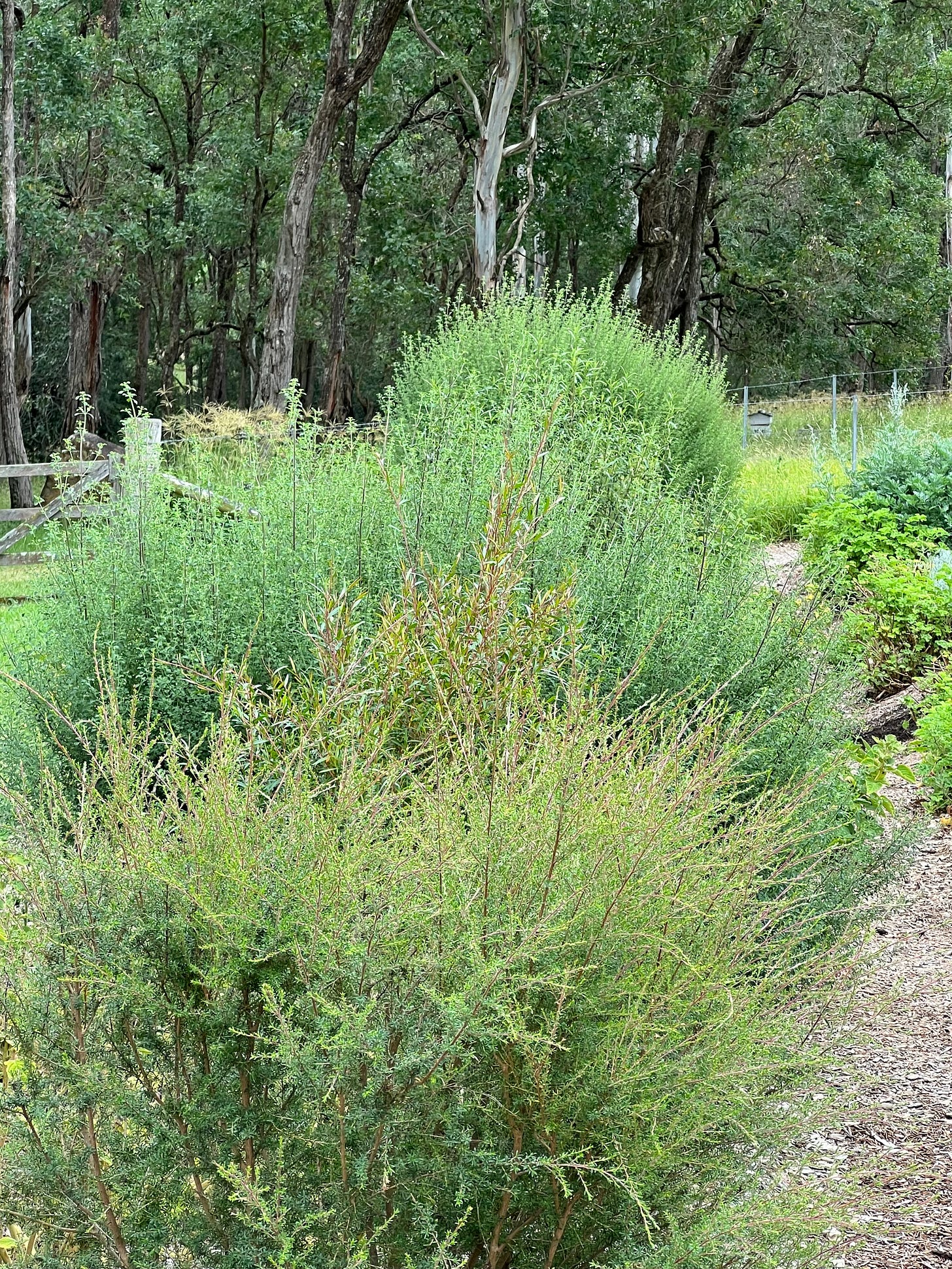
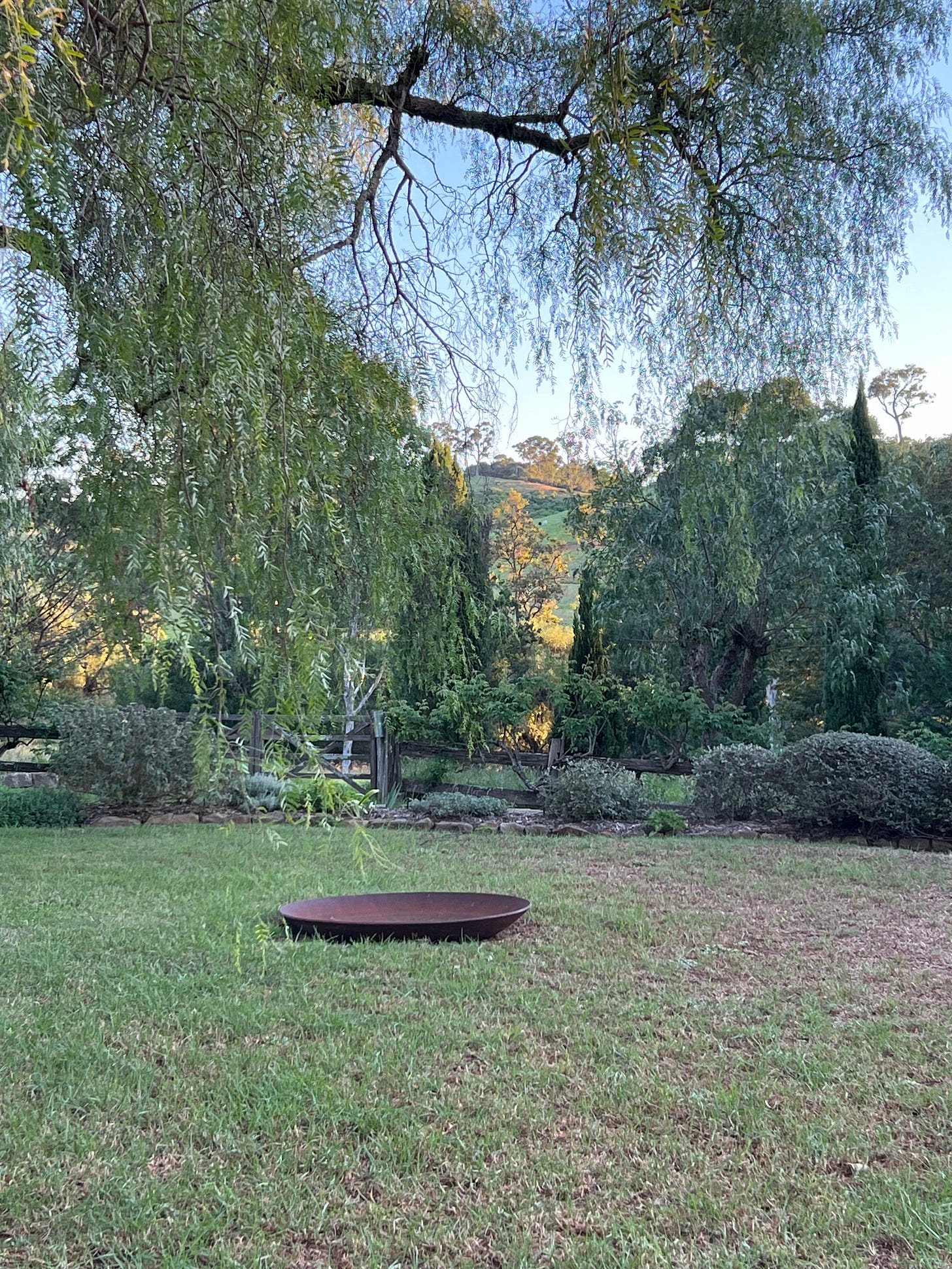
I'll bet you had a chuckle India! I think the scent was from the leaves themselves...there wasn't much cloth on view...and couldn't get close enough to see how the botanicals were stitched in place. I wonder if organic thread was involved?!! You definitely didn't the letters. X
I did enjoy my visit to the garden show Sally but am sorry to hear you wouldn't be able to make it just now...I wish you well in regaining strength. I'm so glad to hear you're a seed saver...and even if they don't all get sown, it sounds like you too, have a personal seed bank - a valuable thing. Funny...I find Dill to be very temperamental which is a shame because I do love it! It's time to scatter some seed and try again. Please forage away for me and enjoy that treasured pungent taste! Thyme does self sow a lot doesn't it? But it's a valuable one and easily weeded out (or transplanted) so I don't mind. How funny...I haven't had a problem with Pittosporum multiplying. All this just goes to show how we all have our very own little micro-climates to learn. Have a good week Sally...I'll aim for another instalment in the coming days! Mx